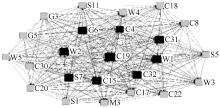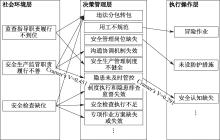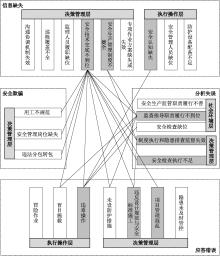| [1] |
BROERE W. Urban underground space: solving the problems of today's cities[J]. Tunnelling and Underground Space Technology, 2016, 55: 245-248.
|
| [2] |
TIXIER A J P, HALLOWELL M R, RAJAGOPALAN B. Construction safety risk modeling and simulation[J]. Risk Analysis, 2017, 37(10):1917-1935.
doi: 10.1111/risa.12772
pmid: 28314065
|
| [3] |
郭中华, 姜卉, 尤完. 建筑施工安全生产监管模式的事故作用机理及有效性评价[J]. 公共管理学报, 2021, 18(4):63-77,170.
|
|
GUO Zhonghua, JIANG Hui, YOU Wan. The influencing mechanism and effectiveness evaluation of safety supervision mode on accidents[J]. Journal of Public Management, 2021, 18(4):63-77,170.
|
| [4] |
GREENWOOD M, WOODS H M. The incidence of industrial accidents upon individuals with specific reference to multiple accidents[R]. Industrial Fatigue Research Board, 1919.
|
| [5] |
光夏磊, 吴超, 王秉. 安全信息思维下的PAR事故致因模型构建及其实证[J]. 情报杂志, 2020, 39(1):179-187.
|
|
GUANG Xialei, WU Chao, WANG Bing. Constructand empirical study of par accident-causing model based on safety & security information thinking[J]. Journal of Intelligence, 2020, 39(1):179-187.
|
| [6] |
HEINRICH H W, PETERSEN D C, ROOS N R, et al. Industrial accident prevention: a safety management approach[M]. New York: McGraw-Hill,1980:22-25.
|
| [7] |
谢振华, 陈茜, 范冰冰, 等. 基于事故致因理论的建筑业事故隐患的界定和排查[J]. 中国安全生产科学技术, 2014, 10(9):113-118.
|
|
XIE Zhenhua, CHEN Xi, FAN Bingbing, et al. Definition and inspection of accident potential in building construction based on accident-causing theories[J]. Journal of Safety Science and Technology, 2014, 10(9):113-118.
|
| [8] |
STURK R, OLSSON L, JOHANSSON J. Risk and decision analysis for large underground projects, as applied to the Stockholm ring road tunnels[J]. Tunnelling and Underground Space Technology, 1996, 11(2): 157-164.
|
| [9] |
EZE E C, IDIAKE J E, GANIYU B O. Analysis of rework risk triggers in the Nigerian construction industry[J]. Organization, Technology & Management in Construction, 2018, 10(1): 1778-1793.
|
| [10] |
雷升祥, 黄明利, 谭忠盛. 城市地下大空间建设风险特征和分类研究[J]. 隧道建设:中英文, 2022, 42(10):1663-1676.
|
|
LEI Shengxiang, HUANG Mingli, TAN Zhongsheng. Risk characteristics and classification of urban large underground space construction[J]. Tunnel Construction, 2022, 42(10):1663-1676.
|
| [11] |
王超. 我国突发性网络舆情事件的关联网络结构分析[J]. 现代情报, 2019, 39(12):121-130.
doi: 10.3969/j.issn.1008-0821.2019.12.014
|
|
WANG Chao. Correlation network structure analysis of emergent network public opinion events in China[J]. Journal of Modern Information, 2019, 39(12):121-130.
|
| [12] |
郑霞忠, 周佳丽, 邵波, 等. 基于D-I的塔机作业物体打击事故致因分析[J]. 中国安全科学学报, 2021, 31(6):83-89.
doi: 10.16265/j.cnki.issn 1003-3033.2021.06.011
|
|
ZHENG Xiazhong, ZHOU Jiali, SHAO Bo, et al. Causal analysis of strike accident of tower crane operating object based on D-I[J]. China Safety Science Journal, 2021, 31(6):83-89.
doi: 10.16265/j.cnki.issn 1003-3033.2021.06.011
|
| [13] |
薛楠楠, 张建荣, 张伟, 等. 基于文本挖掘的建筑工人不安全行为及其影响因素研究[J]. 安全与环境工程, 2021, 28(2):59-65,85.
|
|
XUE Nannan, ZHANG Jianrong, ZHANG Wei, et al. Correlations of construction workers' unsafe behaviors and the influential factors by using text mining[J]. Safety and Environmental Engineering, 2021, 28(2):59-65,85.
|
| [14] |
李显, 焦宇, 陈文涛, 等. 船舶修造企业火灾事故特征挖掘与致因分析[J]. 中国安全科学学报, 2024, 34(3):29-38.
doi: 10.16265/j.cnki.issn1003-3033.2024.03.0368
|
|
LI Xian, JIAO Yu, CHEN Wentao, et al. Feature mining and causative analysis of fire accidents in ship repair and building enterprises[J]. China Safety Science Journal, 2024, 34(3):29-38.
doi: 10.16265/j.cnki.issn1003-3033.2024.03.0368
|
| [15] |
郑秀梅, 田晓康, 柳青, 等. 通用航空事故致因文本挖掘和社会网络分析[J]. 安全与环境学报, 2024, 24(2):602-609.
|
|
ZHENG Xiumei, TIAN Xiaokang, LIU Qing, et al. Text mining and social network analysis of general aviation accident causes[J]. Journal of Safety and Environment, 2024, 24(2):602-609.
|













